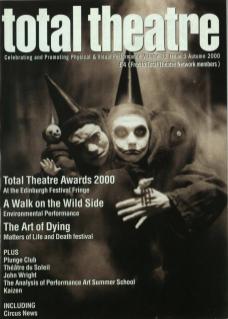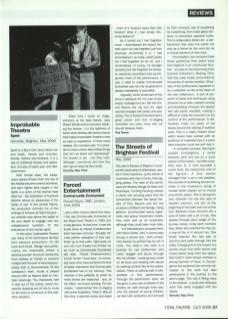This year's Streets of Brighton included the usual array of stiltwalkers, people in furry costumes, quirky bands of musicians and men in funny hats juggling plates. The best of the bunch were the Whalley Range All-Stars and Pearshape. Funding Pending created a clever and amusing piece that fell somewhere between the dance theatre of Pina Bausch and the live sculpture of Gilbert and George. Using gesture, synchronised dance signatures and group movement motifs, they work well as an ensemble, although they could take more risks.
It is interesting to compare them with Disco Sister, who in some ways occupy a similar slot – both companies started by performing live art in clubs. The latter's new work is a journey for two performers who crawl, stagger and dance through the city streets – crossing busy roads on all fours and dealing with abuse by walking zombie-like at the perpetrators. There is nothing safe or predictable in this performance. Through the performers' eyes, we are given a new view of details of the streets we walk through every day. Like the parents of young children, we feel both protective and amused by their innocent use of everything as a plaything, from plate-glass windows to discarded cigarette butts. This is indisputably Street Art – a performance that uses the street not only as a frame for the work but as a crucial element of that work.
Circomedia's new company Dark Horse performed their debut show Dive Urgence in an unfortunate location – so close to the drumming of the Carnival Collective's Beating Time that they were totally surrounded by thousands of samba revellers. What I saw of the performance appeared to be a reflection on life at the dawn of the new millennium – a sort of pot-pourri of ideas and techniques using physical circus skills, cabaret comedy and storytelling. However, the spoken text was totally inaudible, making it difficult to make fair comment on the content of the performance. It did, however, make me aware of the issues around the placing of outdoor work. This is a static theatre show which would have worked with an audience of moderate size in a place were everyone could see and hear it.
In complete contrast, Red Earth created Convergence, a portal between land and sea on a quiet section of the beach. Just after dusk, fires were lit. A man sounded a conch shell, the melancholy note of the fog-horn. A lone woman emerged from a pit in the pebbles, the sounds of scrabbling stones mirrored in the musician's string of mussel shells shaken as he moved around the space. She is facing the sea; between her are two sets of wooden columns, one pair at the beginning of her path and one at the end. Between those columns are a pool of water and a pit of clay. She passes through each stage of the journey slowly, living each moment fully. When she reaches the clay pit, a ring of fire is lit around her. She finally reaches the last pair of columns and walks through into the water. Emerging from the towers is a smoke cloud that drifts above and moves slowly away from the space. Red Earth's work always contains a strong element of ritual. In Convergence the audience are not only witnesses to the work but also participants in the journey to the land's edge. This was a fitting close to the festival – a quiet and reflective work that really engaged with the space.

